stop start Lexus IS200t 2015 Owner's Guide
[x] Cancel search | Manufacturer: LEXUS, Model Year: 2015, Model line: IS200t, Model: Lexus IS200t 2015Pages: 612, PDF Size: 132.21 MB
Page 180 of 612
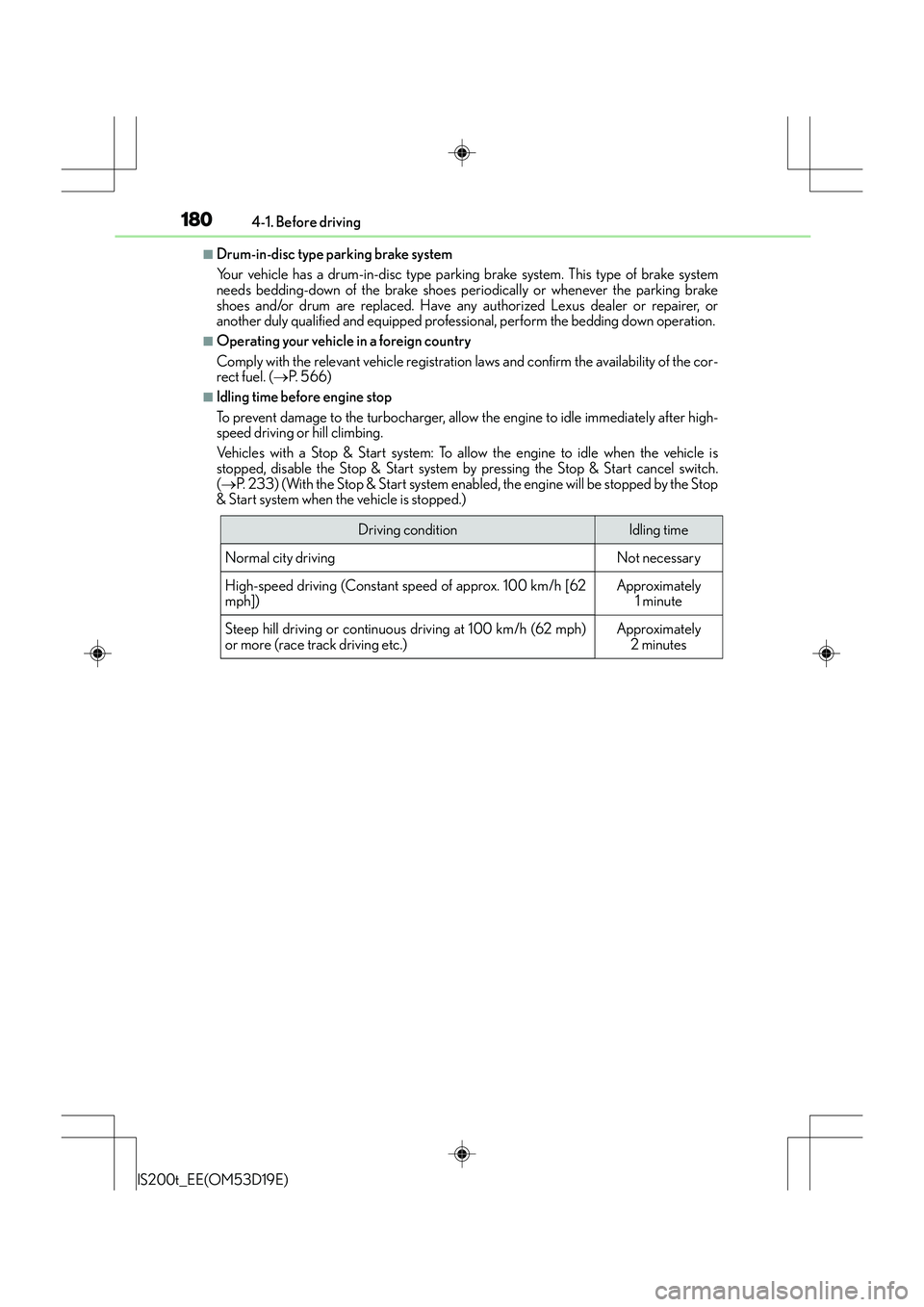
1804-1. Before driving
IS200t_EE(OM53D19E)
■Drum-in-disc type parking brake system
Your vehicle has a drum-in-disc type parking brake system. This type of brake system
needs bedding-down of the brake shoes periodically or whenever the parking brake
shoes and/or drum are replaced. Have any authorized Lexus dealer or repairer, or
another duly qualified and equipped professional, perform the bedding down operation.
■Operating your vehicle in a foreign country
Comply with the relevant vehicle registration laws and confirm the availability of the cor-
rect fuel. ( →P. 5 6 6 )
■Idling time before engine stop
To prevent damage to the turbocharger, allow the engine to idle immediately after high-
speed driving or hill climbing.
Vehicles with a Stop & Start system: To allow the engine to idle when the vehicle is
stopped, disable the Stop & Start system by pressing the Stop & Start cancel switch.
( → P. 233) (With the Stop & Start system enabled, the engine will be stopped by the Stop
& Start system when the vehicle is stopped.)
Driving conditionIdling time
Normal city driving
Not necessary
High-speed driving (Constant sp eed of approx. 100 km/h [62
mph])
Approximately 1 minute
Steep hill driving or continuous driving at 100 km/h (62 mph)
or more (race track driving etc.)
Approximately 2 minutes
Page 181 of 612
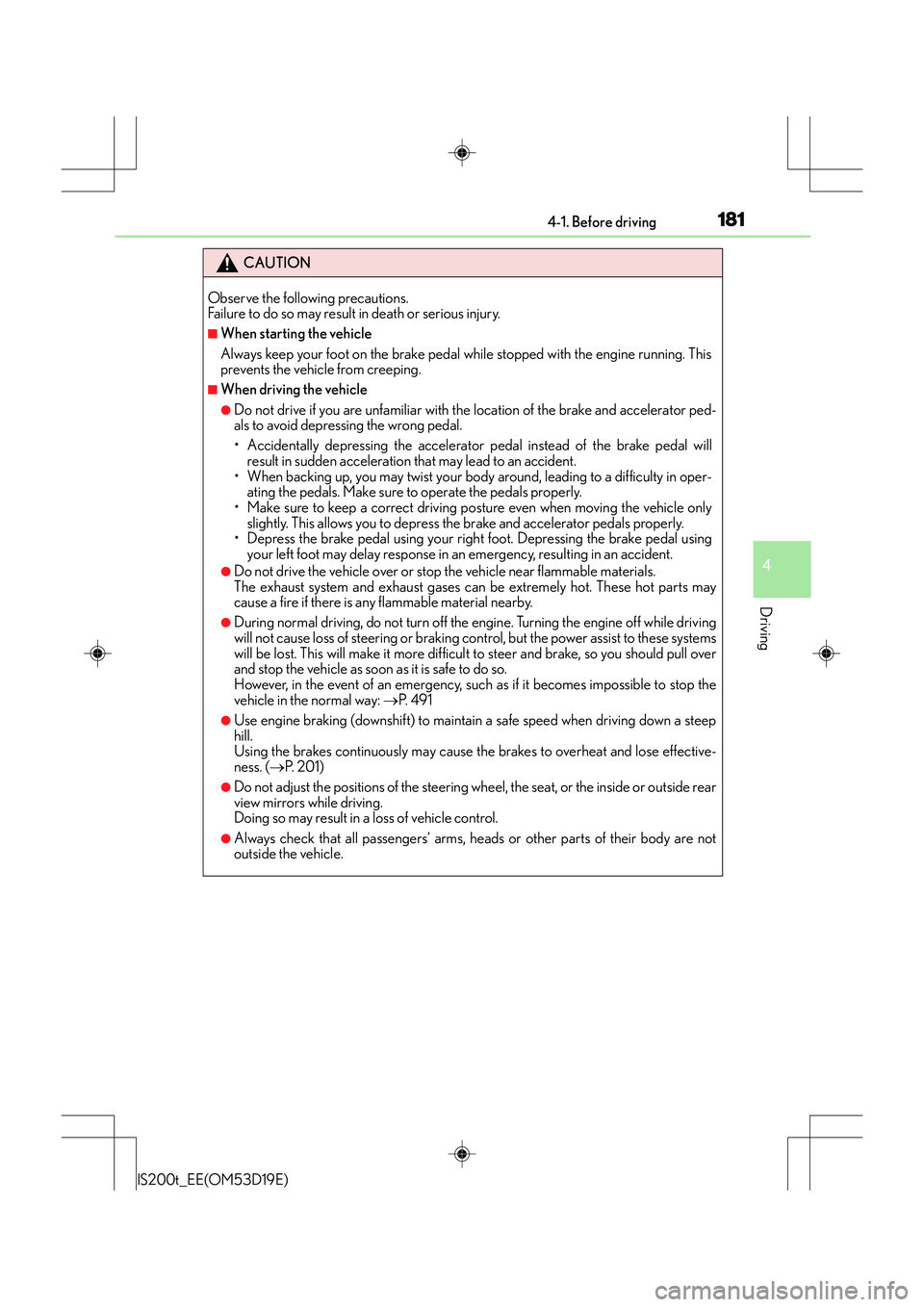
1814-1. Before driving
4
Driving
IS200t_EE(OM53D19E)
CAUTION
Observe the following precautions.
Failure to do so may result in death or serious injury.
■When starting the vehicle
Always keep your foot on the brake pedal while stopped with the engine running. This
prevents the vehicle from creeping.
■When driving the vehicle
●Do not drive if you are unfamiliar with the location of the brake and accelerator ped-
als to avoid depressing the wrong pedal.
• Accidentally depressing the accelerator pedal instead of the brake pedal will result in sudden acceleration that may lead to an accident.
• When backing up, you may twist your body around, leading to a difficulty in oper-
ating the pedals. Make sure to operate the pedals properly.
• Make sure to keep a correct driving posture even when moving the vehicle only slightly. This allows you to depress the brake and accelerator pedals properly.
• Depress the brake pedal using your right foot. Depressing the brake pedal using
your left foot may delay response in an emergency, resulting in an accident.
●Do not drive the vehicle over or stop the vehicle near flammable materials.
The exhaust system and exhaust gases can be extremely hot. These hot parts may
cause a fire if there is any flammable material nearby.
●During normal driving, do not turn off the engine. Turning the engine off while driving
will not cause loss of steering or braking cont rol, but the power assist to these systems
will be lost. This will make it more difficul t to steer and brake, so you should pull over
and stop the vehicle as soon as it is safe to do so.
However, in the event of an emergency, such as if it becomes impossible to stop the
vehicle in the normal way: →P. 4 9 1
●Use engine braking (downshift) to maintain a safe speed when driving down a steep
hill.
Using the brakes continuously may cause the brakes to overheat and lose effective-
ness. ( →P. 2 0 1 )
●Do not adjust the positions of the steering wheel, the seat, or the inside or outside rear
view mirrors while driving.
Doing so may result in a loss of vehicle control.
●Always check that all passengers’ arms, heads or other parts of their body are not
outside the vehicle.
Page 193 of 612
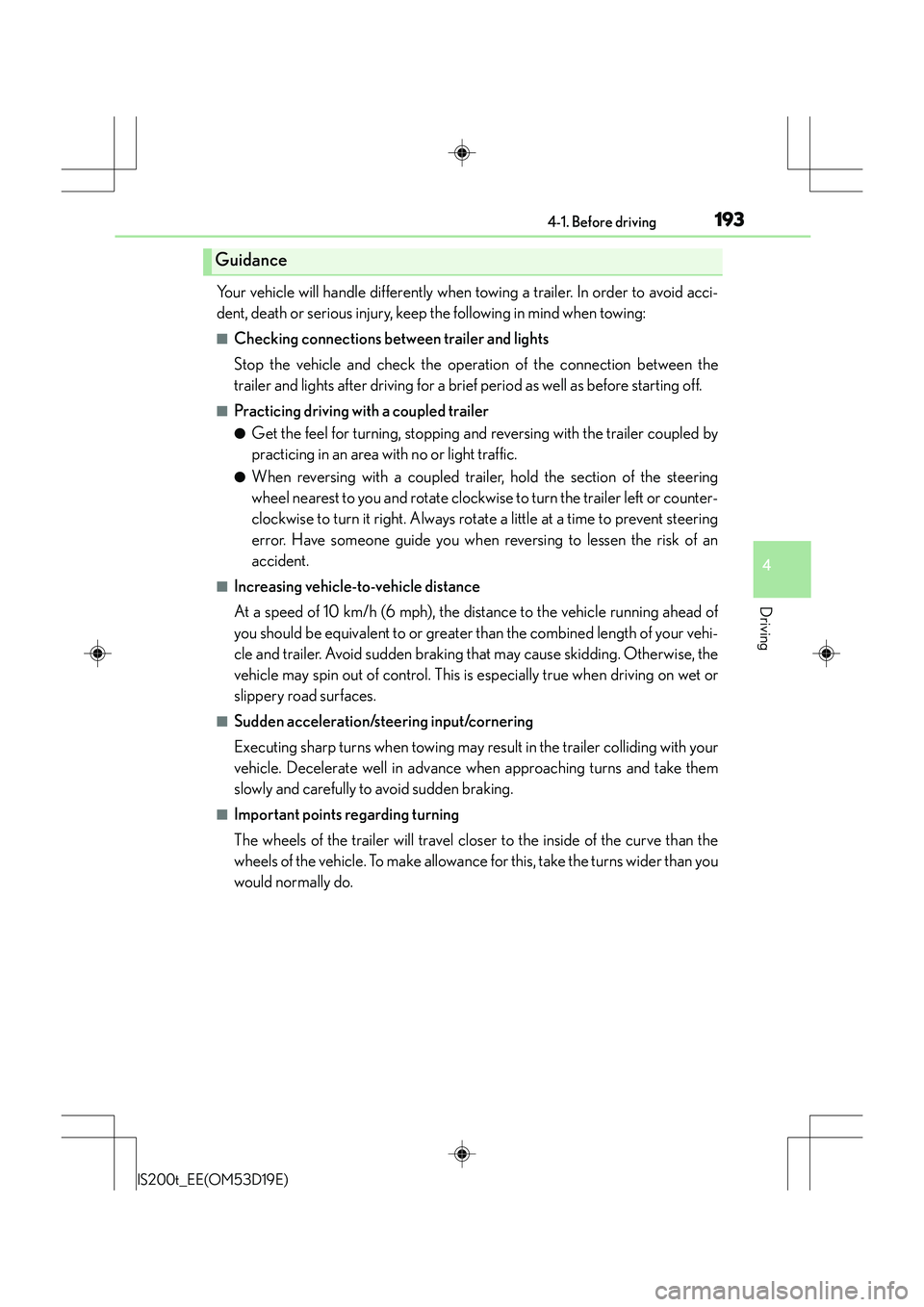
1934-1. Before driving
4
Driving
IS200t_EE(OM53D19E)
Your vehicle will handle differently when towing a trailer. In order to avoid acci-
dent, death or serious injury, keep the following in mind when towing:
■Checking connections between trailer and lights
Stop the vehicle and check the operation of the connection between the
trailer and lights after driving for a brief period as well as before starting off.
■Practicing driving with a coupled trailer
●Get the feel for turning, stopping and reversing with the trailer coupled by
practicing in an area with no or light traffic.
●When reversing with a coupled trailer, hold the section of the steering
wheel nearest to you and rotate clockwise to turn the trailer left or counter-
clockwise to turn it right. Always rotate a little at a time to prevent steering
error. Have someone guide you when reversing to lessen the risk of an
accident.
■Increasing vehicle-to-vehicle distance
At a speed of 10 km/h (6 mph), the distance to the vehicle running ahead of
you should be equivalent to or greater than the combined length of your vehi-
cle and trailer. Avoid sudden braking th at may cause skidding. Otherwise, the
vehicle may spin out of control. This is especially true when driving on wet or
slippery road surfaces.
■Sudden acceleration/steering input/cornering
Executing sharp turns when towing may result in the trailer colliding with your
vehicle. Decelerate well in advance when approaching turns and take them
slowly and carefully to avoid sudden braking.
■Important points regarding turning
The wheels of the trailer will travel closer to the inside of the curve than the
wheels of the vehicle. To make allowance for this, take the turns wider than you
would normally do.
Guidance
Page 194 of 612
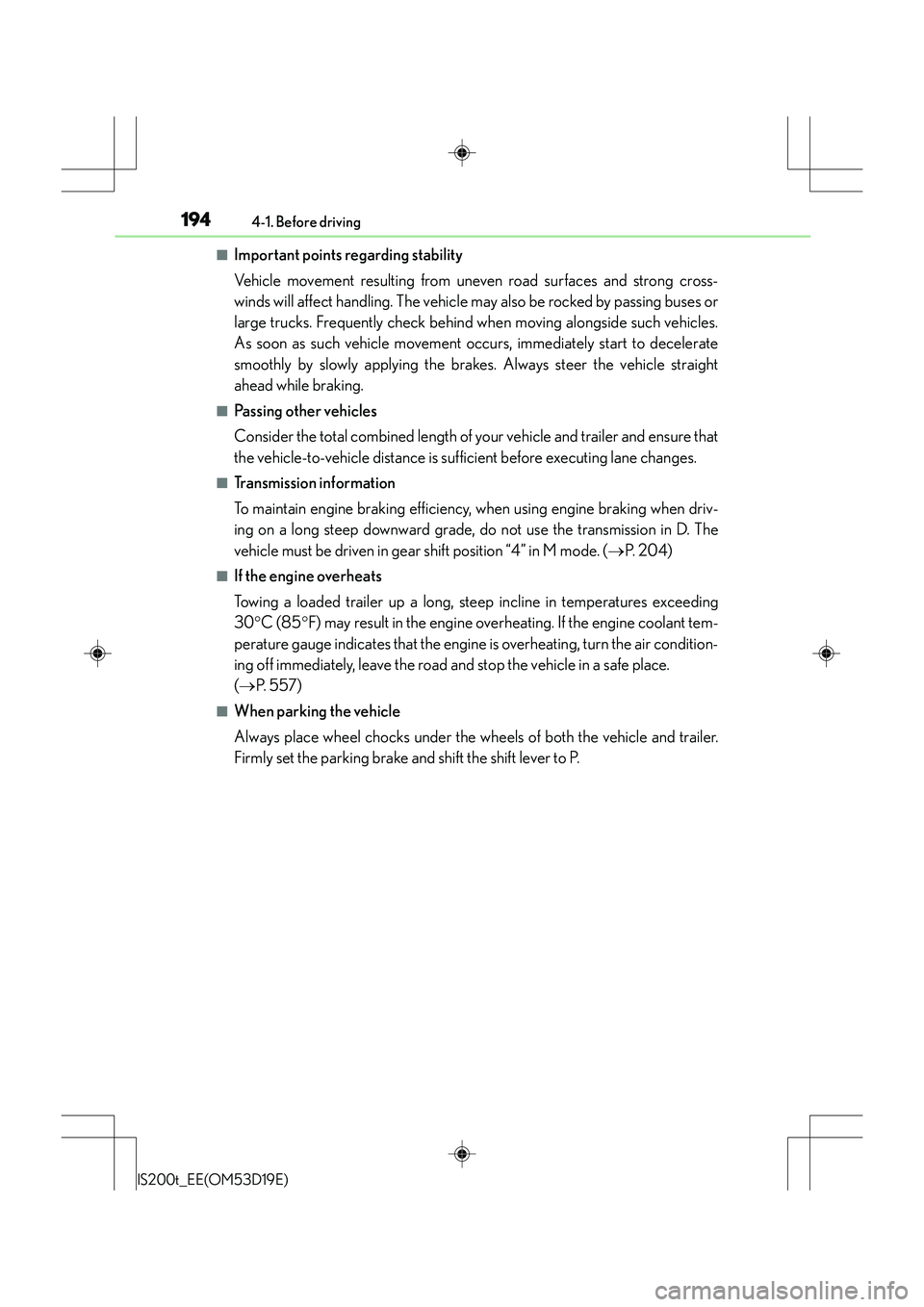
1944-1. Before driving
IS200t_EE(OM53D19E)
■Important points regarding stability
Vehicle movement resulting from uneven road surfaces and strong cross-
winds will affect handling. The vehicle may also be rocked by passing buses or
large trucks. Frequently check behind when moving alongside such vehicles.
As soon as such vehicle movement occurs, immediately start to decelerate
smoothly by slowly applying the brakes. Always steer the vehicle straight
ahead while braking.
■Passing other vehicles
Consider the total combined length of your vehicle and trailer and ensure that
the vehicle-to-vehicle distance is sufficient before executing lane changes.
■Transmission information
To maintain engine braking efficiency, when using engine braking when driv-
ing on a long steep downward grade, do not use the transmission in D. The
vehicle must be driven in gear shift position “4” in M mode. ( →P. 2 0 4 )
■If the engine overheats
Towing a loaded trailer up a long, steep incline in temperatures exceeding
30 °C (85 °F) may result in the engine overheating. If the engine coolant tem-
perature gauge indicates that the engine is overheating, turn the air condition-
ing off immediately, leave the road and stop the vehicle in a safe place.
( → P. 5 5 7 )
■When parking the vehicle
Always place wheel chocks under the whee ls of both the vehicle and trailer.
Firmly set the parking brake and shift the shift lever to P.
Page 196 of 612
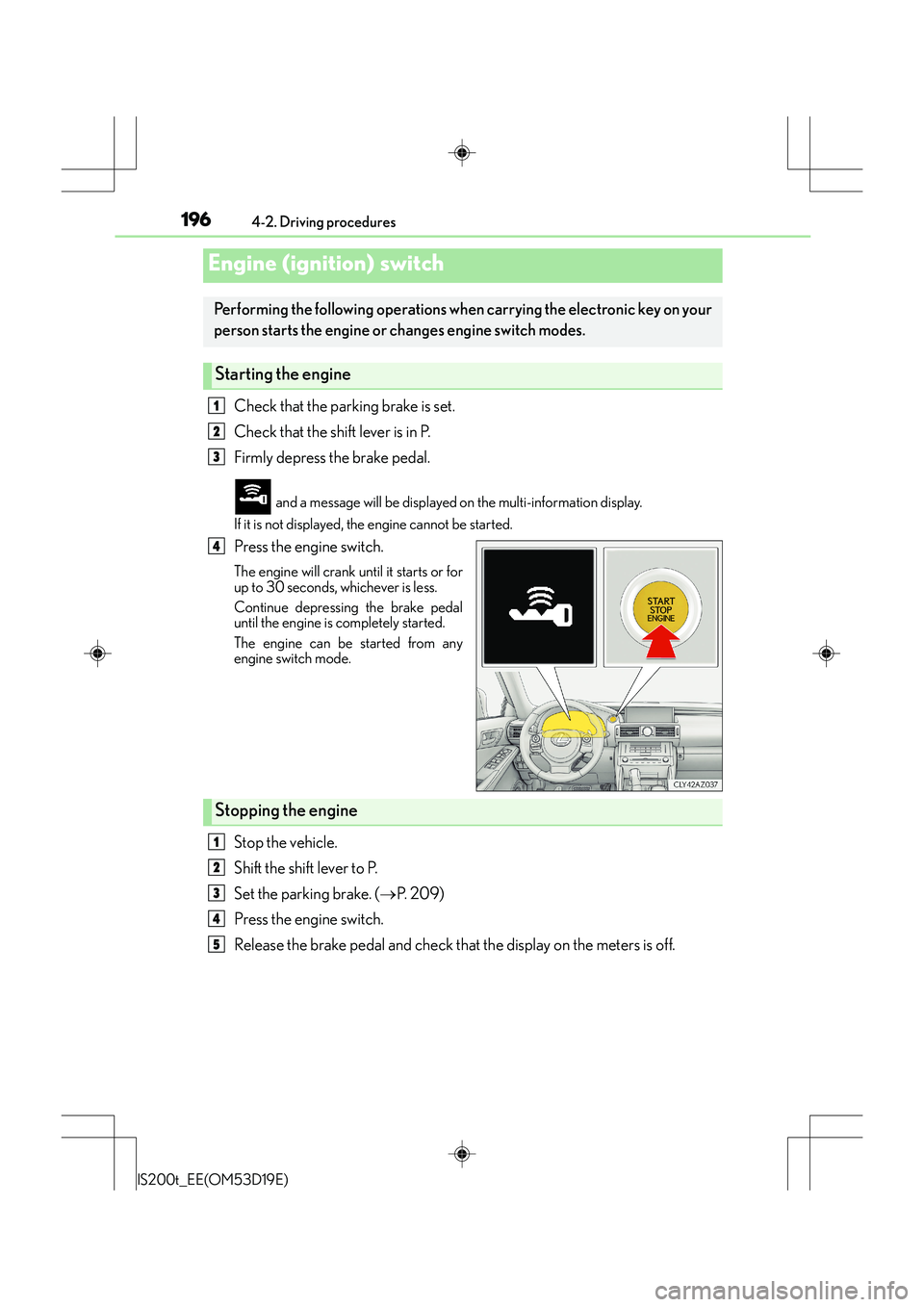
196
IS200t_EE(OM53D19E)4-2. Driving procedures
Check that the parking brake is set.
Check that the shift lever is in P.
Firmly depress the brake pedal.
and a message will be displayed on the multi-information display.
If it is not displayed, the engine cannot be started.
Press the engine switch.
The engine will crank un til it starts or for
up to 30 seconds, whichever is less.
Continue depressing the brake pedal
until the engine is completely started.
The engine can be started from any
engine switch mode.
Stop the vehicle.
Shift the shift lever to P.
Set the parking brake. ( →P. 2 0 9 )
Press the engine switch.
Release the brake pedal and check that the display on the meters is off.
Engine (ignition) switch
Performing the following operations when carrying the electronic key on your
person starts the engine or changes engine switch modes.
Starting the engine
1
2
3
4
Stopping the engine
1
2
3
4
5
Page 199 of 612
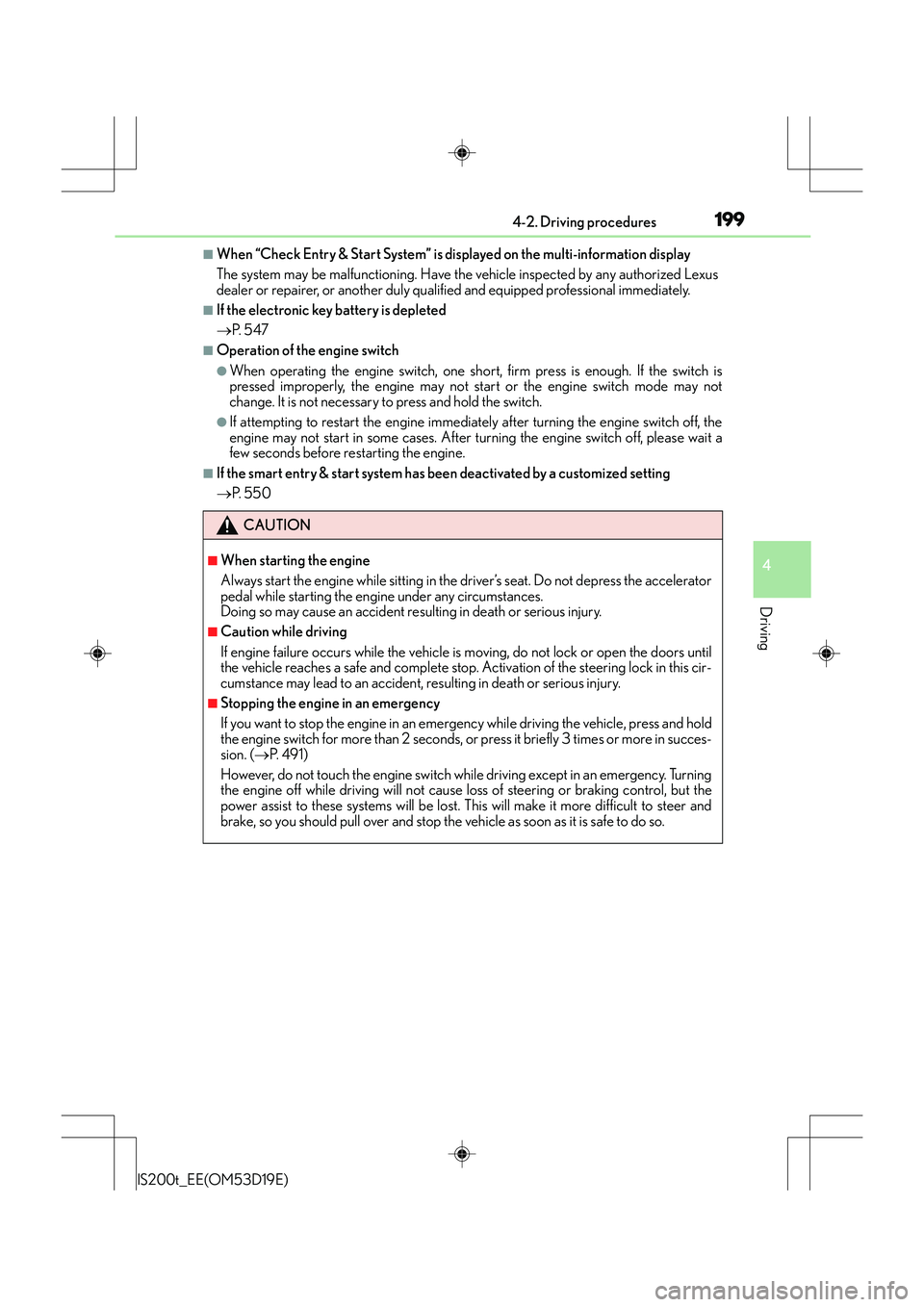
1994-2. Driving procedures
4
Driving
IS200t_EE(OM53D19E)
■When “Check Entry & Start System” is displayed on the multi-information display
The system may be malfunctioning. Have the vehicle inspected by any authorized Lexus
dealer or repairer, or another duly qualified and equipped professional immediately.
■If the electronic key battery is depleted
→P. 5 4 7
■Operation of the engine switch
●When operating the engine switch, one short, firm press is enough. If the switch is
pressed improperly, the engine may not start or the engine switch mode may not
change. It is not necessary to press and hold the switch.
●If attempting to restart the engine immediately after turning the engine switch off, the
engine may not start in some cases. After tu rning the engine switch off, please wait a
few seconds before restarting the engine.
■If the smart entry & start system has been deactivated by a customized setting
→ P. 5 5 0
CAUTION
■When starting the engine
Always start the engine while sitting in the driver’s seat. Do not depress the accelerator
pedal while starting the engine under any circumstances.
Doing so may cause an accident resulting in death or serious injury.
■Caution while driving
If engine failure occurs while the vehicle is moving, do not lock or open the doors until
the vehicle reaches a safe and complete stop. Activation of the steering lock in this cir-
cumstance may lead to an accident, resulting in death or serious injury.
■Stopping the engine in an emergency
If you want to stop the engine in an emer gency while driving the vehicle, press and hold
the engine switch for more than 2 seconds, or press it briefly 3 times or more in succes-
sion. ( →P. 4 9 1 )
However, do not touch the engine switch while driving except in an emergency. Turning
the engine off while driving will not cause lo ss of steering or braking control, but the
power assist to these systems will be lost. Th is will make it more difficult to steer and
brake, so you should pull over and stop the vehicle as soon as it is safe to do so.
Page 200 of 612
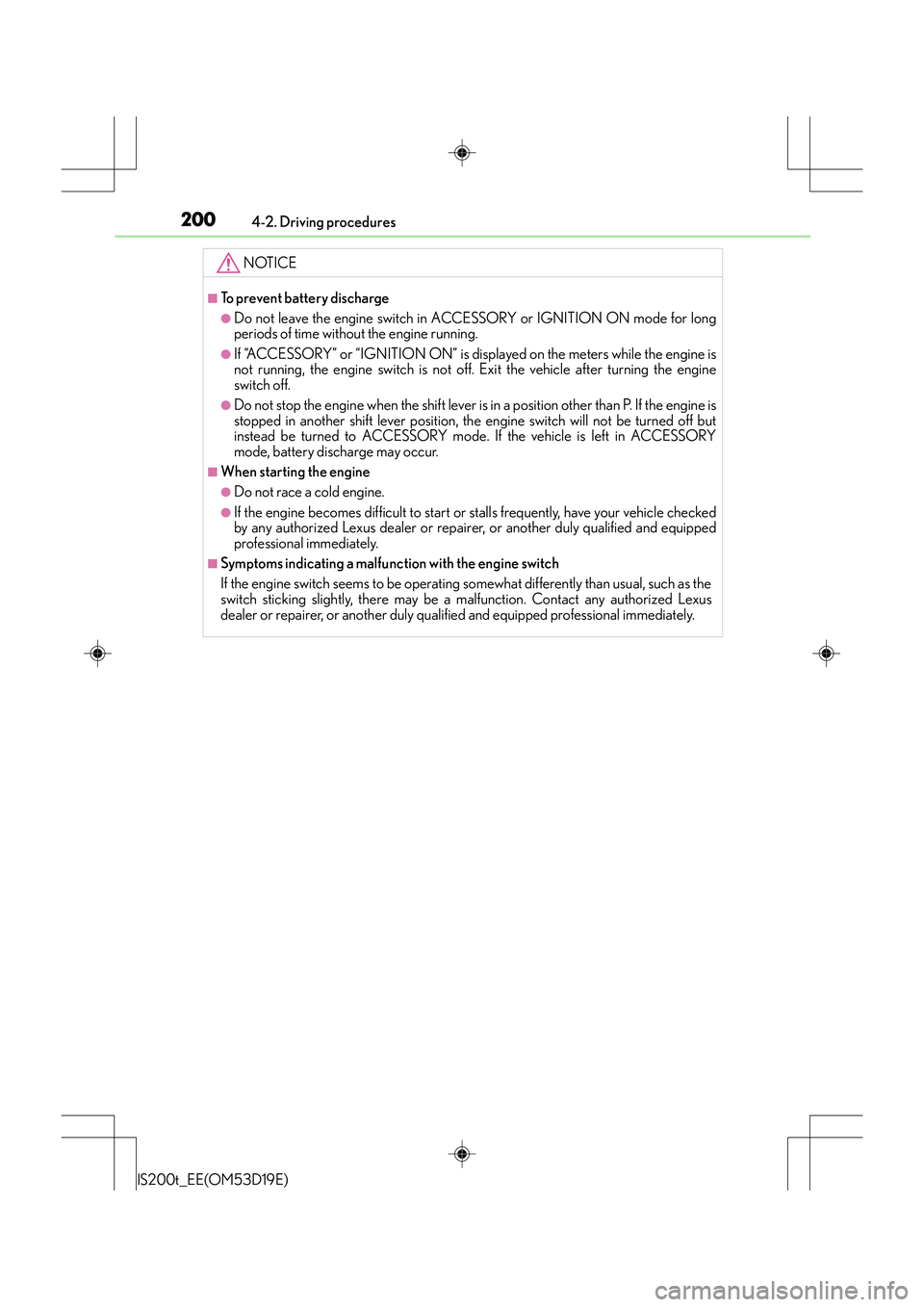
2004-2. Driving procedures
IS200t_EE(OM53D19E)
NOTICE
■To prevent battery discharge
●Do not leave the engine switch in ACCESSORY or IGNITION ON mode for long
periods of time without the engine running.
●If “ACCESSORY” or “IGNITION ON” is displayed on the meters while the engine is
not running, the engine switch is not off. Exit the vehicle after turning the engine
switch off.
●Do not stop the engine when the shift lever is in a position other than P. If the engine is
stopped in another shift lever position, the engine switch will not be turned off but
instead be turned to ACCESSORY mode. If the vehicle is left in ACCESSORY
mode, battery discharge may occur.
■When starting the engine
●Do not race a cold engine.
●If the engine becomes difficult to start or stalls frequently, have your vehicle checked
by any authorized Lexus dealer or repair er, or another duly qualified and equipped
professional immediately.
■Symptoms indicating a malfunction with the engine switch
If the engine switch seems to be operating somewhat differently than usual, such as the
switch sticking slightly, there may be a malfunction. Contact any authorized Lexus
dealer or repairer, or another duly qualif ied and equipped professional immediately.
Page 231 of 612
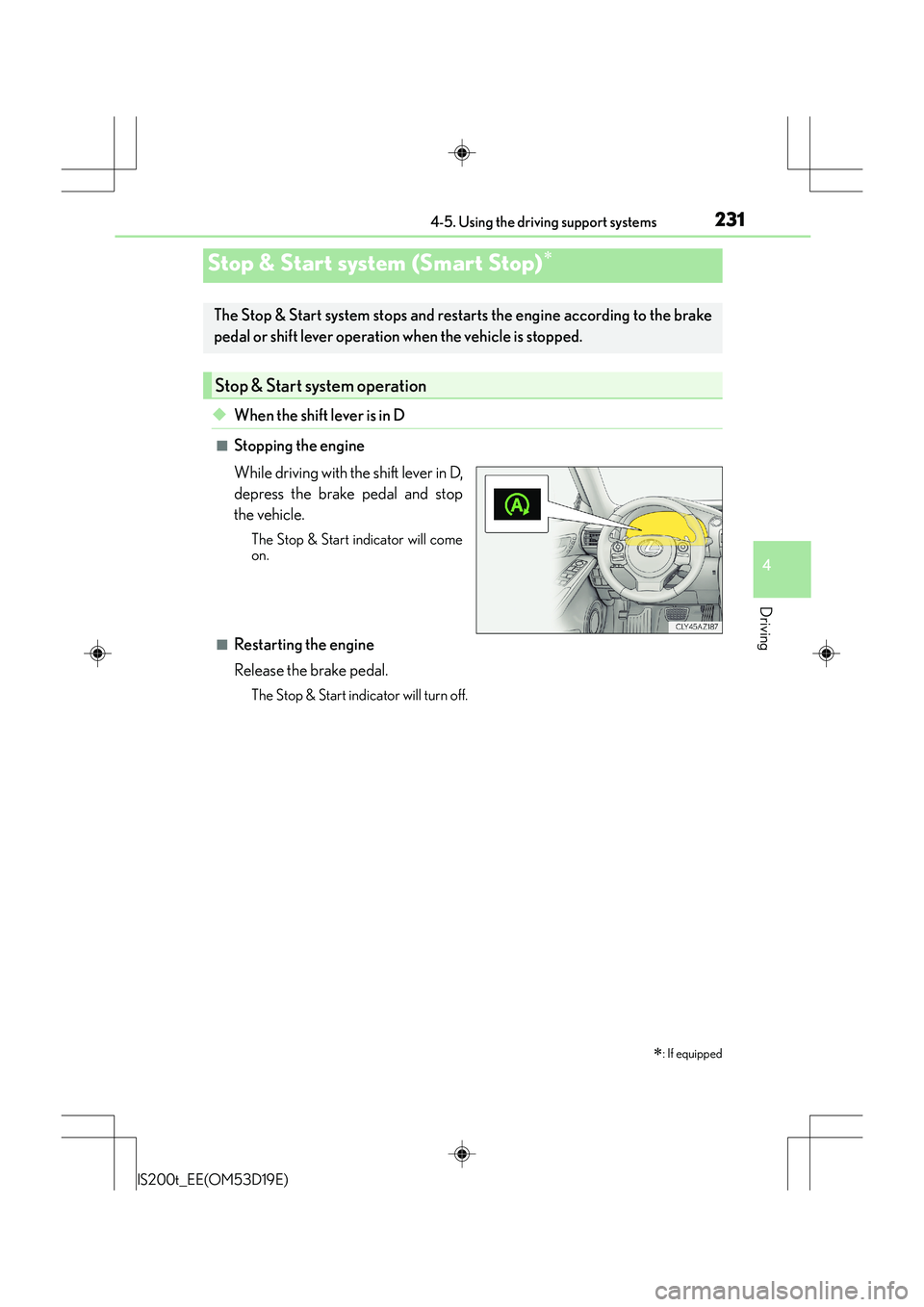
231
4
Driving
IS200t_EE(OM53D19E)4-5. Using the driving support systems
◆When the shift lever is in D
■Stopping the engine
While driving with the shift lever in D,
depress the brake pedal and stop
the vehicle.
The Stop & Start indicator will come
on.
■Restarting the engine
Release the brake pedal.
The Stop & Start indicator will turn off.
Stop & Start system (Smart Stop)∗
∗
: If equipped
The Stop & Start system stops and restar ts the engine according to the brake
pedal or shift lever operation when the vehicle is stopped.
Stop & Start system operation
Page 232 of 612
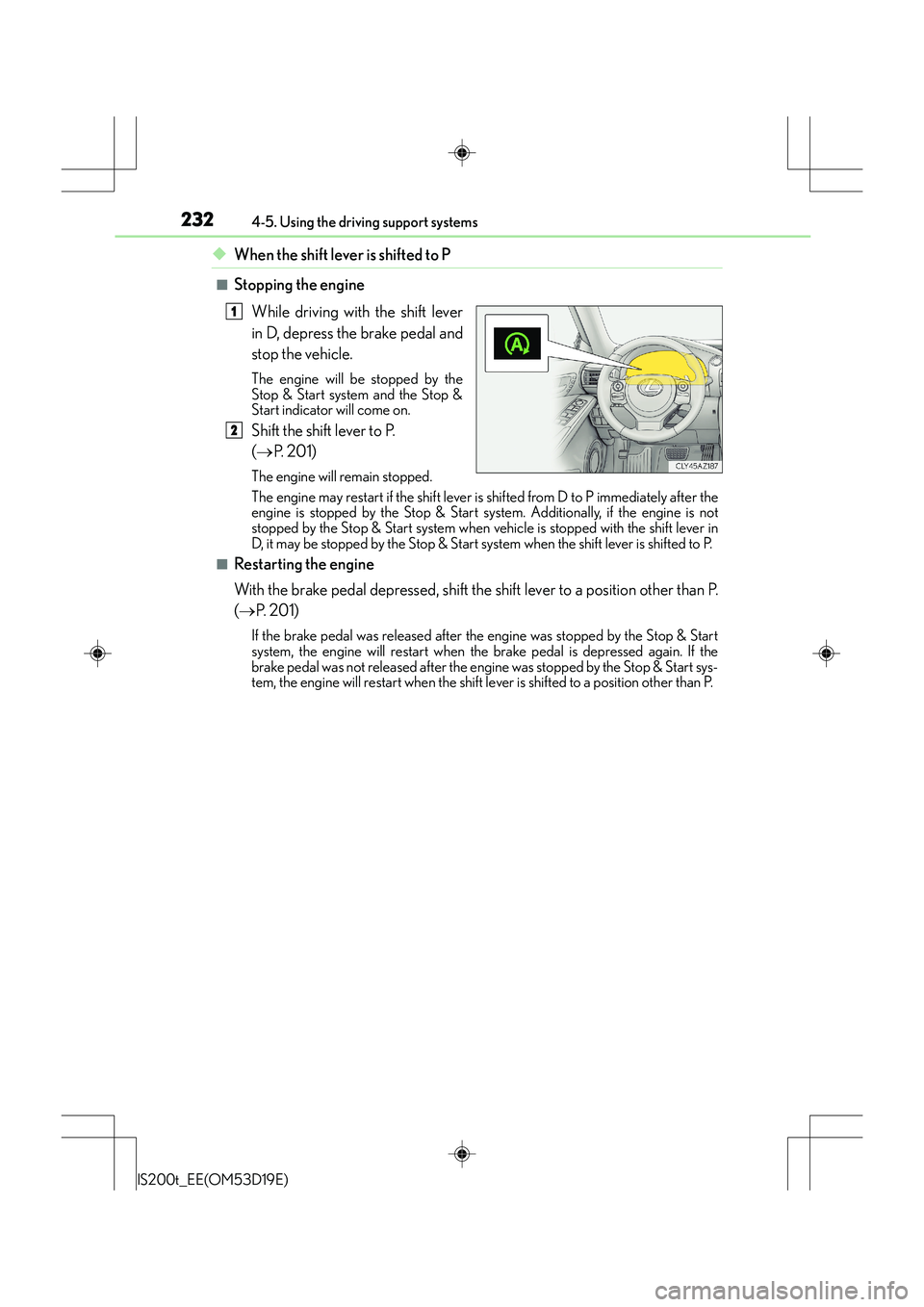
2324-5. Using the driving support systems
IS200t_EE(OM53D19E)
◆When the shift lever is shifted to P
■Stopping the engineWhile driving with the shift lever
in D, depress the brake pedal and
stop the vehicle.
The engine will be stopped by the
Stop & Start system and the Stop &
Start indicator will come on.
Shift the shift lever to P.
(→ P. 2 0 1 )
The engine will remain stopped.
The engine may restart if the shift lever is shifted from D to P immediately after the
engine is stopped by the Stop & Start sy stem. Additionally, if the engine is not
stopped by the Stop & Start system when vehicle is stopped with the shift lever in
D, it may be stopped by the Stop & Start sy stem when the shift lever is shifted to P.
■Restarting the engine
With the brake pedal depressed, shift the shift lever to a position other than P.
( → P. 2 0 1 )
If the brake pedal was released after the engine was stopped by the Stop & Start
system, the engine will restart when the brake pedal is depressed again. If the
brake pedal was not released after the engine was stopped by the Stop & Start sys-
tem, the engine will restart when the shift le ver is shifted to a position other than P.
1
2
Page 233 of 612
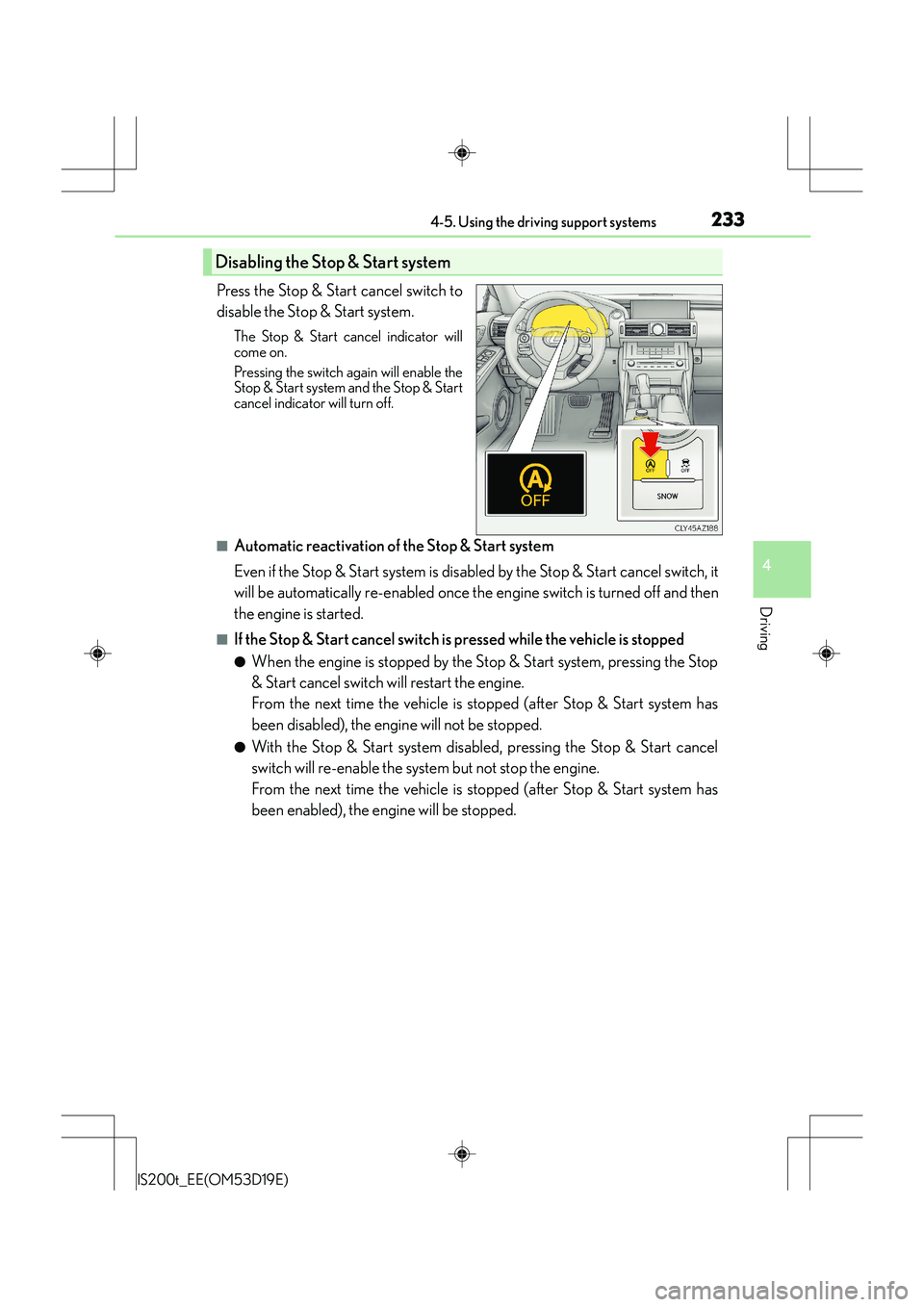
2334-5. Using the driving support systems
4
Driving
IS200t_EE(OM53D19E)
Press the Stop & Start cancel switch to
disable the Stop & Start system.
The Stop & Start cancel indicator will
come on.
Pressing the switch again will enable the
Stop & Start system and the Stop & Start
cancel indicator will turn off.
■Automatic reactivation of the Stop & Start system
Even if the Stop & Start system is disabled by the Stop & Start cancel switch, it
will be automatically re-enabled once the engine switch is turned off and then
the engine is started.
■If the Stop & Start cancel switch is pressed while the vehicle is stopped
●When the engine is stopped by the Stop & Start system, pressing the Stop
& Start cancel switch will restart the engine.
From the next time the vehicle is stopped (after Stop & Start system has
been disabled), the engine will not be stopped.
●With the Stop & Start system disabled, pressing the Stop & Start cancel
switch will re-enable the system but not stop the engine.
From the next time the vehicle is stopped (after Stop & Start system has
been enabled), the engine will be stopped.
Disabling the Stop & Start system